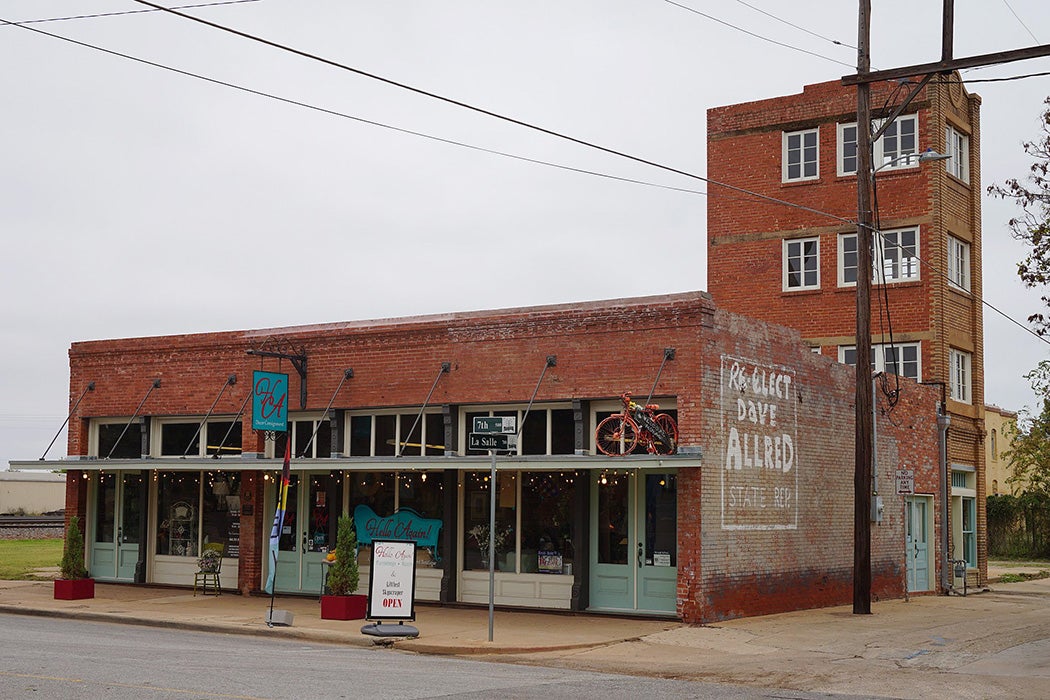In the 1910s and ’20s, Texas and Oklahoma experienced a boom. In 1911, oil was discovered in Wichita County. By 1918, three oil fields had been discovered in the small Texas county that bordered Oklahoma, leading to an influx of prospectors looking to get in, get rich, and get out. New refineries opened, new railroads were built. Things were looking up. As historian Jahue Anderson explains, “a Wichita Falls citizen could stroll through downtown, catch the street railway car, pass irrigated fields […] take a leisurely cruise across the lake, or enjoy dancing to touring music acts.”
But with the arrival of new residents and establishment of new businesses, space was at a premium, particularly in one boomtown, Wichita Falls. Pre-boom, Wichita Falls had around 8,000 residents, but between 1910 and 1920 the population expanded five times over, to about 40,000. And though growth represented new opportunities for workers, it also represented new frontiers for scammers. As Roger M. Olien and Diana Davids Olien describe in their historical study of oil promoters, the discovery of new oil fields also mean a boom in the industry of confidence games. But one conman who made his way to Wichita Falls left more than empty pockets in his wake. He also left the town with one of its notable landmarks—the “world’s littlest skyscraper.”
Wichita Falls needed more office space to house new ventures. Oilman J. D. McMahon had a plan (some sources note that McMahon may not be his actual name; many details of his biography and his plan have been lost to history): he’d build a skyscraper, a huge building in the city’s downtown, big enough to house the offices of all the newly rich business executives.
McMahon, like many of the residents of Wichita Falls, came from out of town. As historian Matthew Day explains,
the oil excitement across the Texas Plains had attracted national attention—so much so that the idea of major investors buying a local oil conglomerate brought a new realm of possibilities for the regions that they served.
Even one of the nation’s most prominent families, the Guggenheims, “considered the Texas Plains oasis a prime area for diversifying their operations.” Already earning a fortune in mining, oil seemed a logical next frontier. The “volatility of oil and gas operations could produce higher profits than hard-mineral extraction,” notes Day, making petroleum industry investments that much more enticing.
McMahon effortlessly sold stock in his business venture, raising $200,000 from investors who hoped that this could be their opportunity for riches. He even had blueprints in hand, grand plans that showed the majestic building rising in the city’s center. But as legend has it, the scale of the blueprints was off. The 480-foot building was actually 480 inches. The resulting building was a compact four stories high and about twelve feet wide and twenty feet deep. Hardly the Empire State Building. By the time it was completed in 1919, McMahon was long gone, leaving his miniature skyscraper as a memento.
But the building wasn’t the only reminder of the area’s boom, and ultimately bust, years. What seemed like an opportunity for many actually depressed the prices. As Day writes, one of the consequences was the increased cost of land, and though oil production was up, “prices peaked at almost $2 per barrel in 1926 before falling by roughly one-third in 1927.”
Weekly Newsletter
And as Anderson explains, an irrigation project that would have created twenty-to-forty-acre farms also faltered during this time, partly a result of increased cost for land and partly because “[o]il interests and large landowners wished to retain lands for oil leasing.” Ultimately, the project may have been the product of boom excitement rather that a deep interest in agriculture, as water and soil quality seemed secondary to promoting the idea of “commodious, comfortable country homes” for “citizens that would till the land, pay taxes, and generate the revenue needed to run the project.”
Though many did get rich from the oil boom, by the end “thousands of ‘suckers’ had been separated from their money,” Grossman writes. And though the smallest skyscraper, now called the Newby–McMahon Building, was originally just a boomtown scam, it’s now a landmark and popular tourist attraction for Wichita Falls.







